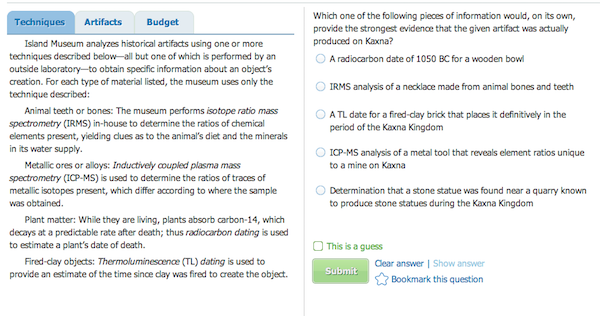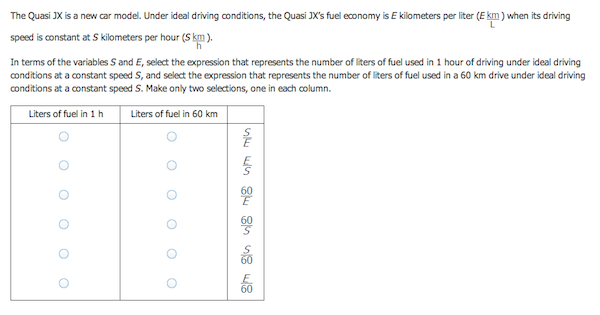
Introduced in June of 2012, Integrated Reasoning is the newest section of the GMAT. The test makers added this challenging section to emphasize skills of data interpretation on their business school exam.
This guide will go over everything you need to know about the Integrated Reasoning GMAT section, including its purpose, question types, and how you can prepare for it. To start, let’s go over a basic overview of GMAT IR.
What Is the Integrated Reasoning GMAT Section?
As of June 5, 2012, GMAT Integrated Reasoning (IR) is the second section of the exam, after the 30-minute Analytical Writing Assessment. It’s 30 minutes long and asks 12 questions, leaving you with an average of 2.5 minutes per question.
The section is scored between 1 and 8 in single unit intervals. Your Integrated Reasoning score doesn’t count toward your total score out of 800, which is based solely on your Quantitative and Verbal scores.
When you look at Integrated Reasoning sample questions, you’ll see a variety of tables, charts, and graphs. Some questions will also feature passages. Your job in this section is to interpret and synthesize data from multiple sources and to use this data to draw conclusions and evaluate statements.
Not sure how or what to study? Confused by how to improve your score in the shortest time possible? We've created the only Online GMAT Prep Program that identifies your strengths and weaknesses, customizes a study plan, coaches you through lessons and quizzes, and adapts your study plan as you improve.
We believe PrepScholar GMAT is the best GMAT prep program available, especially if you find it hard to organize your study schedule and don't want to spend a ton of money on the other companies' one-size-fits-all study plans.

The tables have sorting functionality, so you’ll be able to reorganize information in alphabetical or increasing numerical order to highlight what’s most important. You can also use an on-screen calculator tool for questions that require math.
The GMAT Integrated Reasoning section is all about data. You’ll sort through a large amount of information, pick out significant details, and use a combination of math and verbal skills.
So why did the test makers add this data-heavy section to the GMAT in the summer of 2012?

What’s the Purpose of the Integrated Reasoning GMAT Section?
According to the Graduate Management Admission Council (GMAC), skills of “integrated reasoning” are very important for success in the world of business. Business leaders today need to analyze sophisticated streams of data and synthesize complex information to solve problems.
In 2012, GMAC spoke with over 600 employers across the world and asked them to rate how important “integrated reasoning” skills were to their business. The majority of employers said that these skills were essential for business school graduates and that they looked for evidence of them during the hiring process.
Integrated reasoning skills are also important during business school, when students examine hypothetical case studies and solve problems using evidence from multiple sources. Since GMAC tries to make the GMAT as relevant to business schools and employers as possible, it added the Integrated Reasoning section to reflect these expectations.
While employers agree that integrated reasoning is an essential skill, it’s unclear how much emphasis business schools place on the GMAT IR section. As it’s relatively new to the test, does the Integrated Reasoning score matter in business school admissions?
Does the GMAT Integrated Reasoning Score Matter?
Whenever we start to wade into admissions decision territory, the waters get a little murky. Business schools don’t share exactly how much emphasis they place on GMAT scores, instead insisting that their admissions process is holistic and based on a number of factors, including work experience, essays, and recommendation letters.
The clearest idea we have about the importance of the Integrated Reasoning GMAT score comes from Kaplan’s surveys of admissions officers at 200 business schools in the US. In 2015, 59% of respondents said that an applicant’s GMAT IR score was an important part of their evaluation, a significant increase from the 41% that said it was important in 2014 and a huge jump up from 22% in 2012.
As officers have gotten more familiar with the GMAT Integrated Reasoning section (and GMAC has heavily promoted the section), its role in the admissions process has grown. This trend will likely continue as more and more applicants send scores from the updated version of the GMAT.
While math and verbal scores are still more important than IR scores, you should still aim for an above average (ie, above 4.23) score in IR, and even higher if you’re applying to a selective school. If you’re sending off strong scores, then a competitive IR score will reinforce the positive impression you make.
You should also prepare for GMAT IR so that you don’t end up exhausting a lot of mental energy on this challenging section before you even get to math or verbal. Before you can start your GMAT Integrated Reasoning practice, first, you need to know what’s tested in the IR section.

What’s Tested in the Integrated Reasoning Section?
As its name indicates, the GMAT IR section calls for an integration of your math and verbal skills. You’ll need to read graphs, charts, and tables and perform simple calculations. You’ll also have to read through passages and pick out important information.
Because of this integration of skills, any prep you do for the math and verbal sections will also help you in IR. The GMAT IR section isn’t about memorizing content. Instead, it asks you to solve problems, think critically, and draw meaningful conclusions.
Each IR question is multi-part, but you don’t get partial credit. You have to answer all parts of a question correctly to get points.
There are four question types in the IR section, and each should show up more or less equally. The four GMAT Integrated Reasoning questions are multi-source reasoning, table analysis, graphics interpretation, and two-part analysis.
Want to improve your GMAT score by 60 points?
We have the industry's leading GMAT prep program. Built by Harvard, MIT, Stanford, and Wharton alumni and GMAT 99th percentile scorers, the program learns your strengths and weaknesses and customizes a curriculum so you get the most effective prep possible.

If you see a certain question type a disproportionate number of times, then one or more of those question types is probably experimental and unscored. However, you don’t really have any way of knowing which ones are experimental, so you should treat all of them as equally important.
Read on for a description and example of each of the Integrated Reasoning GMAT questions, plus some tips on how to approach each one.
#1: Multi-Source Reasoning Questions
Multi-source reasoning questions will present you with three different tabs of information. You could get a mix of passages, charts, and graphs, or you could see three of the same source type. Each source will present information on a shared topic.
You’ll get a few questions related to the tabs, and these questions may take one of two formats. The first format is a typical multiple choice question with five answer choices.
The second format involves a two-column grid. In each column, you’ll need to select between two dichotomous choices, like yes/no, true/false, or increase/decrease.
The example below shows a multi-source reasoning question paired with a multiple choice question. As you can see, the first source presents information in the form of a passage. On the real GMAT, you’ll be able to click through each tab to look at all three sources of data.


How to Approach
Multi-source reasoning questions are the most time-consuming question type in the GMAT IR section. They have three different pages of information and several questions that relate to the same topic.
As you prep for the GMAT, you might allow yourself a little longer time on these question types than on the others. You’ll need to review information on three tabs to tackle the questions.
You may have to compare and contrast the various sources. In this way, these questions are similar to reading comprehension questions in the Verbal section. You must be able to comprehend main points, locate details, and synthesize ideas.
#2: Table Analysis Questions
You don’t have to deal with multiple sources of information in table analysis questions. You just have to look at a large table full of data. This table will have sorting functionality, so you can use the drop down menu to rearrange the data by column.
These questions present several statements, and you’ll choose between two dichotomous answer choices, like yes/no, true/false, or, as in the sample below, would help explain/would not help explain.

How to Approach
When answering table analysis questions, you need to take time to understand what the question is asking you to do. In the sample above, you need to determine whether each statement would help explain the information in the table.
Want to Identify YOUR GMAT Strengths and Weaknesses?
Our proprietary GMAT Diagnostic Assessment creates a customized study plan for you that takes you from registration all the way to test day! It is included with every account and proven to significantly maximize your score.
Get your personalized assessment as part of your 5 day risk-free trial now:

For instance, the table shows that only 5% of the Russian population visits a natural history museum each year. This percentage is the lowest of the other countries on the graph. The second statement, “Russia has the fewest natural history museums per capita,” could be one reason why so few people visit natural history museums. If this statement were true, it “would help explain” the information in the table.
As you can see, table analysis questions are not always straightforward, and you need to take some time reading the question and statements to understand what they’re asking.
A table may also be presented in a misleading way. For instance, a question may ask about a ratio from X to Y, and the table may show the ratio from Y to X. It’s your job to use the drop down menu and sort the data in the right way to answer the accompanying question.
On the above sample question, for instance, you could sort by each of the five columns: country/political union, public library, zoo/aquarium, natural history museum, or science/technology exam. If you sort by country/political union, then the countries will rearrange themselves in alphabetical order. If you sort by any of the other columns, then the data will go in order from the smallest number to the largest.
The sorting kind of resembles online shopping. If you were shopping for watches on Amazon, for instance, you could sort them from lowest price to highest. Similarly, you can sort each numerical column in GMAT table analysis questions from lowest value to highest value.
By taking advantage of sorting functionality, you can get to your answers in the most efficient way.

#3: Graphics Interpretation Questions
While multi-source reasoning questions may or may not have graphics, graphics interpretation questions definitely do. You could get any kind of graph or chart, like a pie graph, line chart, bar graph, scatter plot, or some other unusual graphic.
Below the graphic, you’ll get two sentences that ask you to fill in the blank. Instead of a blank line, you’ll get drop down menus and be asked to choose among a few answer choices.
As long as you can readily interpret the graphic, these questions tend to be less time-consuming than the others. The sample question below shows T-Rex mass by age.

How to Approach
To prepare for these questions, you should get comfortable reading graphs, charts, and other graphics. Make sure you can immediately understand what a graphic is communicating and collect data from it.
For instance, you may need to find the mean, median, or range of data from a graph. All of these concepts are also useful for the GMAT Quantitative section.
#4: Two-Part Analysis
Two-part analysis questions start with some short introductory material. Then, you’ll see a chart, as in the example below, and need to select one answer in each column.
These questions can be entirely verbal or entirely mathematical. Often, you have to find your answer for one column before you’re able to figure out your answer for the other one.
The example below is a mathematical two-part analysis question that asks you to work with speed and time to figure out how many liters of fuel a car is using.


How to Approach
These questions could call on your math or verbal skills; you don’t really know which. To prepare, you should especially develop your reading comprehension skills, so you know exactly what the two-part question is asking you to do.
You should also review how to calculate rate, speed, profit, and other concepts common to Quantitative word problems.
Beyond understanding the four question types, what else do you need to do to prepare for the GMAT IR section?
How to Prepare for Integrated Reasoning: 9 Tips
What are the best ways to prep for the Integrated Reasoning GMAT section? What skills are specific to this section, and what practice do you need to do to be successful?
Read on for nine key tips to rease your GMAT Integrated Reasoning score, six to guide your prep and the final three to shape your approach on test day.
#1: Brush Up On Your Graph Reading Skills
There isn’t a whole lot of new content or concepts you need to study for the GMAT Integrated Reasoning section. For the most part, it relies on the same math, verbal, and critical reasoning skills that you need for the other sections of the GMAT.
What is unique about GMAT Integrated Reasoning is its inclusion of various graphics, like bar graphs, scatter plots, and line graphs. To get ready, you should review how to interpret data from a variety of graphs and charts, as well as look over unconventional graphics that communicate data in some way.
There’s a lot of work in the GMAT IR section in only 30 minutes, so you don’t want to waste time trying to figure out how to read a certain type of graph. Before you test, get comfortable interpreting data from various sources so that you can readily understand each graphic when you take the test.

#2: Notice Where Math and Verbal Skills Overlap
As mentioned above, you don’t need to memorize a bunch of formulas or learn new vocabulary to do well in IR. In terms of math, you may need to use arithmetic to add numbers or calculate percentages, rates, or profits. You may also need to interpret word problems and figure out what steps to take to solve the problems.
All of these skills are also important for the math section, so they should fall into your Quantitative prep. Similarly, the prep you do for reading comprehension and critical reasoning questions in the Verbal section will help you in the IR section.
If you’re practicing arithmetic, reading comprehension, or critical reasoning for the math and verbal sections, then you may also drill these skills with IR questions. You’ll reinforce fundamental skills, which will help you on all three sections of the GMAT.
#3: Develop a Test-Taking Rhythm With Practice Tests
One major challenge of the IR section is sorting through complex information in a short amount of time. While there are just 12 questions, each question has multiple parts. For all intents and purposes, there are quite a few more than 12 questions in this 30-minute section.
Taking timed GMAT Integrated Reasoning practice tests and paying attention to the timer will help you develop a sense of pacing. You might set certain benchmarks, like you’ll aim to have six to seven questions answered by the time 15 minutes have gone by.
If you haven’t reached that goal, then you might want to take an informed guess on a particularly confusing question. It might be better to skip a question somewhere in the middle than wait, run out of time, and have to guess on a later question that you had a better chance of getting right.
You should also note that some question types may take longer than others. Multi-source reasoning questions, for instance, have three tabs of information, while the other question types only have one. You might allocate more time to answer these questions than other ones.
You should also take time after each practice test to reflect on how much time you spent per question. Some practice tests will show you how much time you spent on each question to help you examine your performance.

#4: Answer Realistic Sample Questions
In addition to taking timed practice tests, you should also practice with realistic, computer-based IR questions. The best ones come from the test makers, and you can find sample questions on the free GMAT Prep Software. You can also purchase additional practice questions and practice tests.
You might also use unofficial practice questions from third parties, but they should represent the same format as what you’ll see on the GMAT. You should be able to click through tabs, sort charts, and use an on-screen calculator tool.
One of the hardest things about GMAT IR questions is figuring out what they’re asking and understanding how to approach answering them. By answering lots of sample questions, you’ll get more skilled at comprehending these tricky, often confusing questions.
#5: Practice Using the On-Screen Calculator
You can’t use your own calculator, but will be able to access an on-screen calculator during the GMAT IR section. You shouldn’t need to make many advanced calculations, but the calculator can be a time saver on math-oriented questions that require you to add up a column of numbers or calculate a percentage.
Using an on-screen calculator can be awkward if you’re not used to it, so practice with it before test day. That way, the calculator will be a time saver and not a time waster.
#6: Study Just Enough to Meet Your Goals
While you definitely don’t want to bomb the GMAT IR section, you also don’t need to take it quite as seriously as the verbal and math sections. At this point, it’s still unclear how much emphasis business schools put on IR scores, and there may be applicants sending scores from the pre-IR section version of the GMAT.
That being said, the IR section is challenging, and you do want to know what you’re up against. If you go into the test blind, then you’ll exhaust a lot of mental energy here before even getting to the math and verbal sections, thereby compromising your math, verbal, and total scores.
Set an IR score goal and work towards it, but balance your prep time in favor of the math and verbal sections.

#7: Be Picky About What Data Matters
There’s a lot of extraneous information in each question. Your job is to sort through the fluff and pick out the important details – just like in integrated reasoning for real life jobs.
Glancing over the data first may help you get your bearings, but then you should read the question. Think carefully about what it’s asking and what you need to know to answer it.
Then, you can look directly for relevant information and pick it out from the table, chart, graph, or passage before you. Your task is not to interpret every piece of information, but rather to sift apart what’s important and what isn’t.
#8: Take Advantage of Sorting Functionality
To help you root out important data, tables and charts have sorting functionality. As discussed above, you can use a drop down menu to reorganize information by different columns.
You can sort a table by columns, and it will rearrange itself in alphabetical order or by lowest to highest number. A table will rarely be organized in a helpful way right off the bat. In fact, it may present information in a way designed to trip you up.
You should carefully read what a question is looking for and then sort the table to prioritize certain data points over others.
#9: Know When to Guess and Move On
As you know, the GMAT IR section is strictly timed and fast paced. If a question totally stumps you, then you might need to make your best guess and move on.
It’s important to answer all of the questions in the section. You’ll get a worse score penalty for missing questions than for getting one wrong.
Since there are some experimental questions thrown in, you can even get a few wrong and still get top scores. If timing is an issue or a question is completely throwing you off, then you should give yourself permission to guess and move on.
If you follow these tips as you get for and take the GMAT, then you’ll be in a good position to tackle the IR section. As we finish up, let’s go over some final thoughts about the Integrated Reasoning section on the GMAT.

Integrated Reasoning GMAT: Final Thoughts
The Integrated Reasoning section was added in 2012 to introduce skills of data interpretation to the GMAT. To excel in business school and beyond, you should be able to evaluate and synthesize information from multiple data streams and use your analysis to make informed decisions.
Since the IR section is relatively new, it hasn’t yet taken on a great deal of importance in business school admissions decisions. That being said, it’s growing in importance each year, and you should still aim to get an above average GMAT Integrated Reasoning score.
To get ready for the IR section, you should practice reading graphs and charts and answer plenty of practice questions. Since this section integrates various skills, your math, verbal, and critical reasoning skills that you develop for other sections will also be useful.
Like the other sections of the GMAT, the IR section wants you to evaluate information and draw evidence-based conclusions. Both of these skills will take central stage in business school and beyond.
What’s Next?
Now that you know all about the Integrated Reasoning section, let’s take a deep dive into one of the most important sections on the GMAT, the Quantitative section. Check out this guide to learn all about the structure, skills, and question types on GMAT math.
Are you familiar with the full format and structure of the GMAT? This comprehensive guide goes over the entire GMAT exam pattern, including sample problems of each and every question type.
Beyond learning about the exam itself, are you interested in how the GMAT is scored? Check out our guide to everything you need to know about GMAT scoring.
 PrepScholar GMAT
PrepScholar GMAT